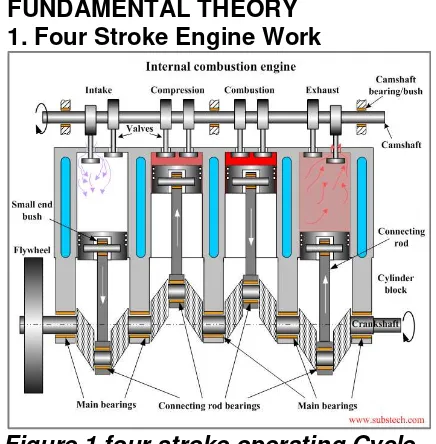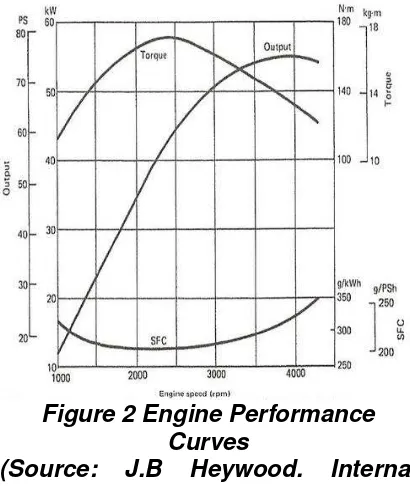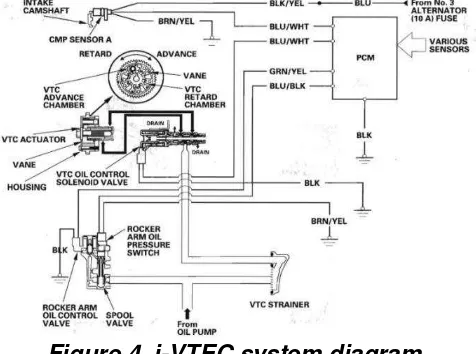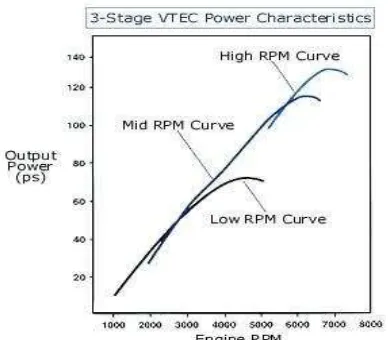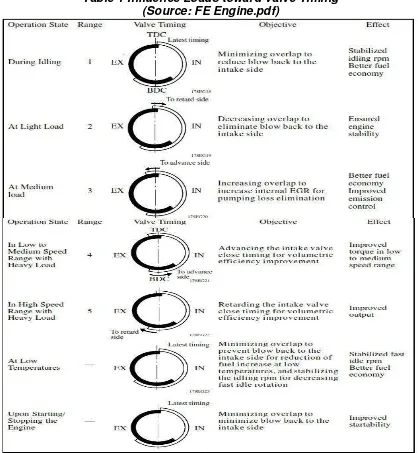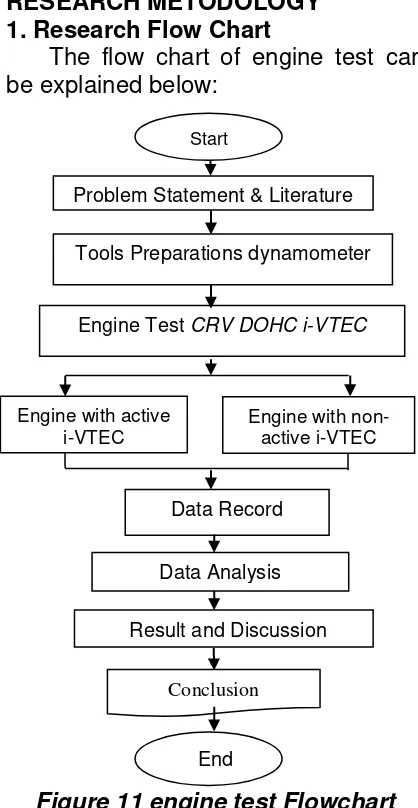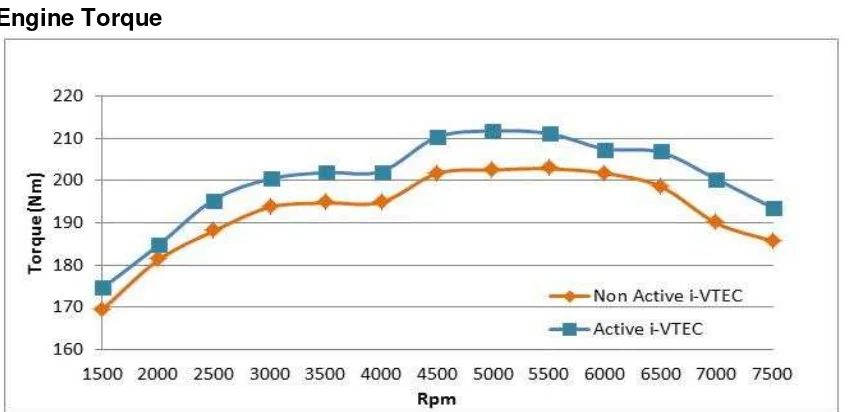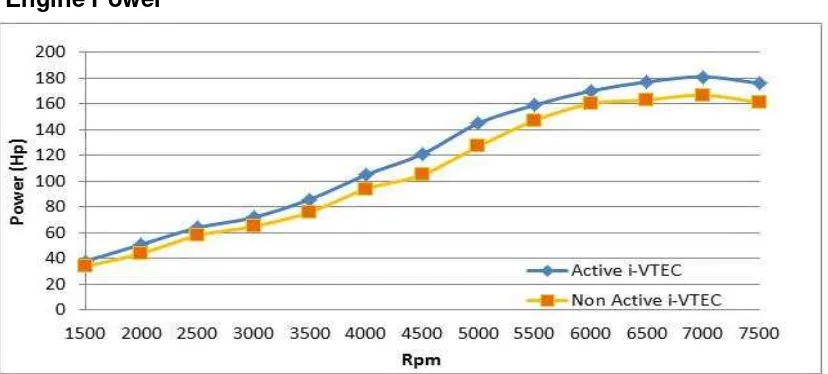PUBLICATION ARTICLE
COMPARISON ANALYSIS OF ENGINE PERFORMANCE
USING I-VTEC SYSTEM AND ENGINE WITHOUT I-VTEC
SYSTEM HONDA CR-V
Submitted as a Partial Fulfillment of the Requirements for Getting the Bachelor Degree of Engineering in Automotive Department
Arranged by :
Jonas Suhardi NIM : D700070001
MECHANICAL ENGINEERING DEPARTMENT
INTERNATIONAL PROGRAM IN
AUTOMOTIVE/MOTORCYCLE ENGINEERING
MUHAMMADIYAH UNIVERSITY OF SURAKARTA
COMPARISON ANALYSIS OF ENGINE PERFORMANCE USING
I-VTEC SYSTEM AND ENGINE WITHOUT I-VTEC SYSTEM HONDA
CR-V
Jonas Suhardi, Sartono Putro, Nur Aklis
Automotive Department of Muhammadiyah University of Surakarta Jln. A. Yani Tromol Pos I Pabelan-Kartasura. Telp. (0271) 715448 Surakarta
ABSTRACT
Vehicle manufactures develop technology which can increase of performance and the engine can have a great power and torque. One of this technology is using Intelligence Variable Timing and Lift Electronic Control (i-VTEC) that can be used to solve problem above because it can control timing valve. i-VTEC can increase engine performance that can make the gasoline engine will increase power and torque. The aim of this research is to compare power and torque on active i-VTEC and non-active i-VTEC system on Honda CRV.
This test was done by installing Honda CR-V 2.4 with active i-VTEC and non-active i-i-VTEC on Dynamometer. The Dynamometer presented the data of power and torque based on engine rotation.
The result from Dynamometer test showed that maximum torque from engine use active i-VTEC is 211.7 Nm at 4900 Rpm and maximum torque from engine non-active i-VTEC is 202.8 Nm at 5350 Rpm. The engine torque using active i-VTEC is 3.67% higher than non-active i-VTEC engine. The maximum power from engine use active i-VTEC system is 181.5 Hp at 6910 Rpm and maximum power from engine non-active VTEC system is 167.7 Hp at 7020 Rpm. The engine power using active i-VTEC is 9.33% higher than non-active i-i-VTEC engine. I-i-VTEC organizes timing of valve which can make overlapping on the machine. Overlapping make number of air fuel mixture in combustion chamber will increase which can make performance will increases.
Keywords: gasoline engine, i-VTEC, Dynamometer, power, torque.
BACKGROUND
Internal combustion engine is a device converting the energy of a fuel-air mixture burning within a combustion chamber into mechanical energy. A mixture of fuel and air, or just air in a diesel engine, is forced by atmospheric (or greater) pressure into the cylinder through the intake port than the intake valve is closed. The volume of air/fuel mixture that is drawn into the cylinder compared to the volume of the cylinder
is called the volumetric efficiency of the engine.
RPM will cause poor engine performance while run in low RPM.
i-VTEC (Intelligent-Variable Valve Timing and Lift Electronic Control) is a valve train system developed by Honda to improve the volumetric efficiency of a four-stroke internal combustion engine. The i-VTEC system uses two camshaft profiles and electronically selects between the profiles.
Based on this background, it is necessary to understand the effect of active i-VTEC and non-active i-VTEC to the gasoline engines performance of Honda CRV.
OBJECTIVE OF THE STUDY
The research objectives are compares the power and torque on active i-VTEC and non-active i-VTEC system on Honda CRV.
REVIEW OF LITERATURE
Sanjaya, Danil (2012), his research about the comparison analysis performance of Honda Jazz using active vtec and non-active vtec system engine. His research concluded data from analysis torque and power. The highest engine torque can be reached when the engine use active VTEC system. Maximum torque from engine use active VTEC is 99.8 FtLb at 4990 rpm and The highest engine power can be reached when the engine use active VTEC system is 111 Hp at 6020 rpm.
Siswanto,Y.D (2012), his research study about the effect of variety lobe separation angle camshaft to engine power. The research use LSA standard 104o, LSA widened camshaft 107o and LSA narrowed camshaft 101o at different engine speed. Based on the data analysis, it concluded that the change of LSA narrowed camshaft 1. Four Stroke Engine Work
Figure 1 four stroke operating Cycle (Source : www. Substech.com)
a. Intake Stroke
Intake valve is open and exhaust valve is close. The piston descends from the top of the cylinder to the bottom of the cylinder, reducing the pressure inside the cylinder. A mixture of fuel and air, or just air in a diesel engine, is forced by atmospheric (or greater) pressure into the cylinder through the intake port. The volume of air/fuel mixture that is drawn into the cylinder, relative to the volume of the cylinder is called, the volumetric efficiency of the engine.
b. Compression Stroke
c. Expansion Stroke
While the piston is close to Top Dead Center, the compressed air–fuel mixture in a gasoline engine is ignited, usually by a spark plug, The resulting massive pressure from the combustion of the compressed fuel-air mixture forces the piston back down toward bottom dead center.
d. Exhaust Stroke
During the exhaust stroke, exhaust valve open. This action evacuates the burnt products of combustion from the cylinder by expelling the spent fuel air mixture out through the exhaust valve.
2. Engine Performance Parameter a. Torque (T)
Torque is the twisting force or energy that an engine produces. Torque is multiplication between force and radius that can be formulated as
3. Engine Performance Characteristic
Engine performance characteristic are convenient graphical presentation
of an engine performance. Both torque and power are functions of engine speed.
At low speed, torque increases as engine speed increases. As engine speed increases further, torque reaches a maximum called Maximum brake torque (MBT) and then decreases as shown in Figure 2.6. Torque decreases because the engine is unable to ingest a full charge of air at higher speeds.
Indicated power increases with speed, while brake power increases to a maximum and then decreases at higher speeds. This is because friction losses increase with speed and become the dominant factor at very high speeds.
Figure 2 Engine Performance Curves
(Source: J.B Heywood. Internal combustion engine fundamentals)
4. Volumetric Efficiency
The parameter used to measure the effectiveness of an engine induction proses is the volumetric efficiency. It is defined as the volume flow rate of air into the intake system divided by the rate at which volume is displaced by the piston.
where:
ma = mass of air into the engine
ρa = air density
Vd = displacement volume
5. Valve Timing
Valve timing is a system that developed for measuring valve operation in relation to crankshaft position (in degrees), particularly the points when the valves open, how long they remain open, and when they close.
Figure 3 Valve Timing (Source: valves and valve
machanism.pdf)
6. i-VTEC System Construction
The i-VTEC system is designed to control the intake camshaft to provide valve timing that is optimally suited to the engine condition
Figure 4 i-VTEC system diagram (Source: Honda CR-V Service Manual
Book)
7. Mechanism of VTEC
The mechanism has 3 cams with different timing and lift profile. This mechanism operated is like this:
Figure 5. VTEC Mechanism (Source:www.howstuffwork.com/
engine-valve-technology)
Stage 1 ( low speed ) : the 3 pieces of rocker arms moves independently. Therefore the left rocker arm, which actuates the left inlet valve, is driven by the low-lift left cam. The right rocker arm, which actuates the right inlet valve, is driven by the medium-lift right cam
their own. As a result, both inlet valves obtain slow timing but medium lift.
Stage 3 ( high speed ) : hydraulic pressure connects all 3 rocker arms together. Since the middle cam is the largest, both inlet valves are actually driven by that fast cam. Therefore, fast timing and high lift are obtained in both valves.
As seen from the power curve graph, each of the three stages has a distinct curve. The optimal portions for the three stages can be combined into one curve.
Figure 6. VTEC Power graphic (Source:www.howstuffwork.com/
engine-valve-technology)
8. Mechanism of VTC Advance
Figure 7. advance position (Source:www.howstuffwork.com/
engine-valve-technology)
The resultant oil pressure is applied to the timing advance side vane chamber to rotate the camshaft in the timing advance direction.
Retard
Figure 8. retard position (Source:www.howstuffwork.com/
engine-valve-technology)
The resultant oil pressure is applied to the timing retard side vane chamber to rotate the camshaft in the timing retard direction.
Hold
The ECM calculates the target timing angle according to the traveling state to perform control as described below.
Figure 9. hold position (Source:www.howstuffwork.com/
engine-valve-technology)
9. Effectiveness of the i-VTEC System
timing is optimized to allow the engine to produce maximum power. The VTEC system changes the cam profile to correspond to the engine speed. It maximizes torque at low engine speed and output at high engine speed.
Figure 10.Conceptual graphic operation during various conditions
(Source: FE Engine.pdf)
RESEARCH METODOLOGY 1. Research Flow Chart
The flow chart of engine test can be explained below:
Figure 11 engine test Flowchart
2. Material
Material that used is spark ignition four stroke engine with the volume cylinder 2354 cc, four cylinder and vertical engine types.
Table 2 Specification of Honda CR-V i-VTEC
Engine specification
Type In-Line 4-Cylinder Valve mechanism 16-Valve DOHC
i-VTEC® Displacement volume 2354 cc Engine configuration 4
Valve configuration 16 Bore x Stroke (mm) 87 x 99
Compression Ratio 10:1 Maximum power
(Ps/rpm) 187 @ 7000 Maximum torque
( Nm/rpm) 222 @ 4400 Carburation system PGM-FI
3. Tools
The dynamometer will be used is digital dynamometer. The output of engine performance parameter is shown by graphic on display. The parameter will be shown are rotation, power and torque.
Figure 12. Scheme of Dynamometer
Legend: 1. Monitor
2. pick up coil sensor 3. pick up coil roller
4. dyno GUI ( graphic user interface ) console
5. Monitor 2 prepare the Honda CRV engine with i-VTEC. Test of performance Honda CRV engine with DOHC i-VTEC on dynotest. After that give trouble on ECU to make i-VTEC on the Honda CRV engine does not work so there is no signal and the hydraulic oil to Start
Tools Preparations dynamometer Problem Statement & Literature
solenoid cannot move and the pin on cam also does not working. Pull out VTC Solenoid valve cable to make trouble on ECU. Then, test of performance of CRV engine with non-active i-VTEC on dynotest.
5. Data Record
1. Power and torque can be obtained by running car on dynamometer. The procedure of data acquisition must be followed. For the first, shift the transmission on the D Lever.
Running the car just like in normal condition then hold the engine then hold the engine speed to 1500 Rpm. Push and Hold the gas pedal until engine reach 7500 Rpm. Then release the gas pedal and wait until engine back to normal condition again.
2. The output data can be read on the monitor that connect to dynamometer.
3. Repeat the step above up to four
times experiments to get the accurate data.
ANALYSIS
1. Engine Torque
Figure 13. Graphic comparison of analysis Torque between active i-VTEC system and non-active i-VTEC system
The highest torque generated by active i-vtec system is 211.7 Nm at 4900 Rpm and the highest torque generated by non-active i-vtec is 202.8 Nm at 5350 Rpm. On low rotation and high rotation, torques has generated by active i-vtec system are higher than torques generated by non-active i-vtec system.
As the result, the mean average value of torque that resulted from engine using active i-VTEC is 200.03 Nm. On other hand, the mean average value of torque that resulted from
engine non-active i-VTEC is 192.69 Nm. The engine torque using active i-VTEC is 3.67% higher than non-active i-VTEC engine. This occurs because the active i-VTEC is advancing the intake valves closing time and opened the intake valves for longer duration based on engine loads. The volumetric efficiency is improved by increasing amount of air that inhaled to combustion chamber which resulting to increasing torque.
Nm at 4400 Rpm. The tested engine give smaller torque value than the torque based on manual book
2. Engine Power
because the engine used for testing is not new engine so engine performance is decreasing.
Figure 14. Graphic comparison of analysis Power between active i-VTEC system and non-active i-VTEC system
The highest power generated by active i-vtec system is 181.5 Hp at 6910 Rpm and the highest power generated by non-active i-vtec is 167.7 Hp at 7020 Rpm. From the graphic, it shows at low and high rotation, active i-vtec system will resulting higher power than non-active i-vtec system.
REFERENCES
Çengel, Y.A dan Boles, M.A. 2006. Thermodynamics: An Engineering Approach, 5th ed. New York: McGraw-Hill.
Ganesan, V. 2003. Internal Combustion Engine Second Edition. New Delhi: Tata McGraw-Hill.
Heywood, John B. 1988. Internal Combustion Engines Fundamentals. New York: McGraw-Hill inc.
Sanjaya, Dhanil. 2012. Comparison Analysis Performance Of Honda Jazz Using Active VTEC System And Non-Active VTEC System Engine. Final Project. Universitas Muhammadiyah Surakarta.
Pulkrabek, Willard W. 2001. Engineering Fundamentals of The Internal Combustion Engine. New Jersey: Prentice Hall.
Soenarta, Nakoela dan Furuhama, Shoici. 1985. Motor Serba Guna. Jakarta: PT Pradnya Paratama.
Subowo, Heri. 2010. “Perkembangan Teknologi Mekanisme Katup Pada Mesin Mobil”.
Tesis. Malang: Progam Pascasarjana Universitas Negeri Malang.
Sutamto, 2009 . Analysis compares the characteristics machine honda jazz i-DSI and VTEC
Tarmedi, Ewo dan Noor, Ridwan Adam M. 2009. “Analisis Efisiensi Volumetric Pada Motor Otto dengan Menggunakan Variable Valve Timing”. Penelitian Mandiri. Bandung: Teknik Mesin, Universitas Pendidikan Indonesia.
Yoyok Drajat Siswanto. 2012. Pengaruh variasi lobe separation angel camshaft dan variasi putaran mesin terhadap daya pada motor Honda supra x 125 tahun 2008. Surakarta: Teknik Mesin. Universitas Sebelas Maret.
http://saft7.com/programtraining/Dynotest/TipsOtomotifSaft7.html. Step 1 Engine Principle. Access on 27 September 2014.
http://autodata.net/HondaCRVIII-2.4i-VTEC/TechnicalSpecification.html Access on 18 September 2014.
http://justgivememanualbook.com/HondaCR-V_OwnerManual/download/
